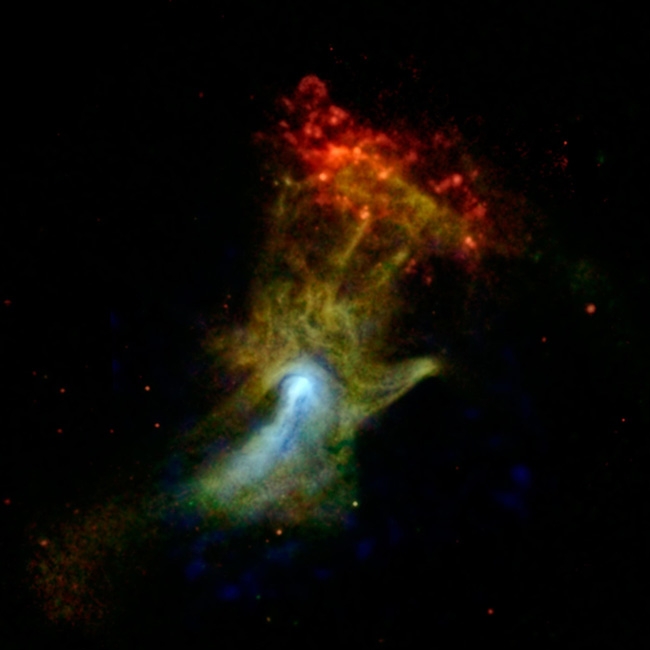NASA Space Telescope Spots the 'Hand Of God' After Incredible Star Explosion
January 10, 2014
Written by Tanya Lewis for Space.com
Religion and astronomy may not overlap often, but a new NASA X-ray image captures a celestial object that resembles the "Hand of God."

Photo: NASA/JPL-Caltech/McGill
The cosmic "hand of God" photo was produced when a star exploded and ejected an enormous cloud of material, which NASA's Nuclear Spectroscopic Telescope Array, or NuSTAR, glimpsed in high-energy X-rays, shown in blue in the photo. NASA's Chandra X-ray Observatory had imaged the green and red parts previously, using lower-energy X-rays.
"NuSTAR's unique viewpoint, in seeing the highest-energy X-rays, is showing us well-studied objects and regions in a whole new light," NuSTAR telescope principal investigator Fiona Harrison, of the California Institute of Technology in Pasadena, said in a statement.
The new image depicts a pulsar wind nebula, produced by the dense remnant of a star that exploded in a supernova. What's left behind is a pulsar, called PSR B1509-58 (B1509 for short), which spins around 7 times per second blowing a wind of particles into material ejected during the star's death throes.
As these particles interact with nearby magnetic fields, they produce an X-ray glow in the shape of a hand. (The pulsar is located near the bright white spot in the image but cannot be seen itself, NASA officials said.)
Scientists aren't sure whether the ejected material actually assumes the shape of a hand, or whether its interaction with the pulsar's particles is just making it appear that way.
"We don't know if the hand shape is an optical illusion," Hongjun An, of McGill University in Montreal, said in a statement. "With NuSTAR, the hand looks more like a fist, which is giving us some clues."
The red cloud appearing at the fingertips is a separate structure called RCW 89. The pulsar's wind may be heating the cloud to produce the low-energy X-ray glow, astronomers believe.
The X-ray energies seen by NuSTAR range from 7 to 25 kiloelectron volts, or keV, whereas the energies seen by Chandra range from 0.5 to 2 keV.
The Hand of God is an example of pareidolia, the psychological phenomenon of perceiving familiar shapes in random or vague images. Other common forms of pareidolia include seeing animals or faces in clouds, or the man in the moon. Despite its supernatural appearance, the Hand of God was produced by natural astrophysical phenomena.
Source: Space.com
Click Here For The Most Popular On Sunny Skyz
 Boy With Down Syndrome Nails The Whitney Houston Challenge, And The Crowd Goes Wild
Boy With Down Syndrome Nails The Whitney Houston Challenge, And The Crowd Goes Wild
 LoweŌĆÖs Staff Refuse To Give Up On Missing Cat, Find Her 85 Miles Away
LoweŌĆÖs Staff Refuse To Give Up On Missing Cat, Find Her 85 Miles Away
 People Are Sharing The Funniest Company Fails After This Health Insurance Letter Went Viral
People Are Sharing The Funniest Company Fails After This Health Insurance Letter Went Viral
 ŌĆśHeavily IntoxicatedŌĆÖ Raccoon Passes Out In Liquor Store Bathroom After Breaking In
ŌĆśHeavily IntoxicatedŌĆÖ Raccoon Passes Out In Liquor Store Bathroom After Breaking In
 Cat With A Gat: Owner 3D Prints Toy Glock, Hours Later Walks In On This
Cat With A Gat: Owner 3D Prints Toy Glock, Hours Later Walks In On This
 The ŌĆśGrandma StandŌĆÖ Is Bringing Comfort And Connection, One Conversation At A Time
The ŌĆśGrandma StandŌĆÖ Is Bringing Comfort And Connection, One Conversation At A Time
 Boy With Down Syndrome Nails The Whitney Houston Challenge, And The Crowd Goes Wild
Boy With Down Syndrome Nails The Whitney Houston Challenge, And The Crowd Goes Wild
 A Struggling Mom Could Not Stop Crying After A StrangerŌĆÖs Christmas Gift
A Struggling Mom Could Not Stop Crying After A StrangerŌĆÖs Christmas Gift
 'That Looks Like Me': Boy Surprises Aunt With Portrait At Art Show
'That Looks Like Me': Boy Surprises Aunt With Portrait At Art Show
 She Was Ready For A Fight With Her Neighbor. His Response Changed Everything
She Was Ready For A Fight With Her Neighbor. His Response Changed Everything
 Dogs In Matching Pajamas Try To Defend Simba From Hyenas
Dogs In Matching Pajamas Try To Defend Simba From Hyenas
